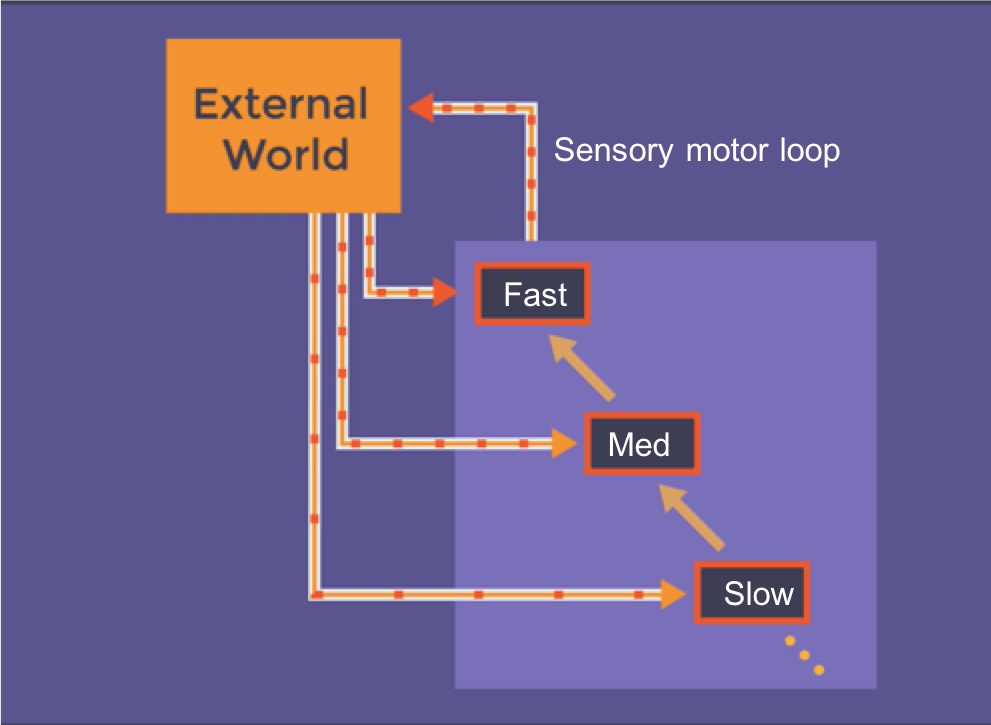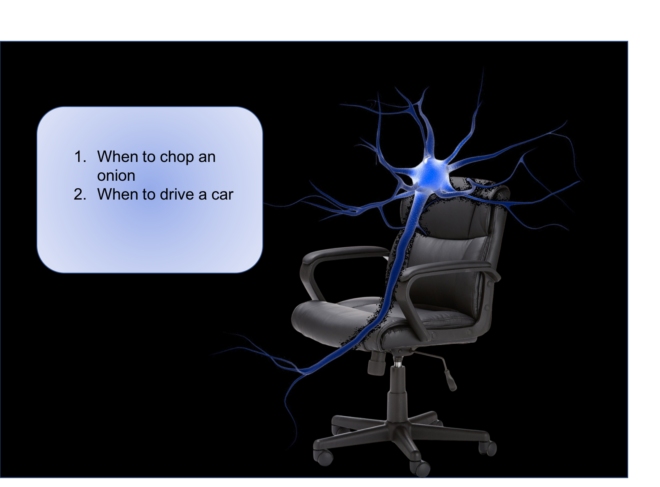Can the fast adaptation of neurons explain how we are able to switch so quickly between different learned behaviors? If so, neurons must learn to adapt. A hypothesis of hierarchical adaptation provides a framework in which to consider this.
In the last couple posts I introduced fast adaptations of neurons and their possible role in brain functioning. The idea was that fast adaptations control the flow of sensory-motor activations throughout the nervous system allowing us to switch quickly from one mode of behavior to another (e.g., from driving car to chopping onion).
Do fast adaptive mechanisms learn?
If fast adaptations are responsible for adjusting the flow of information throughout the brain, how do these mechanisms know what they need to do? Do they need to learn their rules for adaptation? In the preceding post I have described the examples of car driving and onion chopping. Both these activities are skills learned through practice; we are not born with those abilities. Therefore, if fast adaptation-based mechanisms control the routing of sensory-motor loops underlying those behaviors, there must also exist a mechanism for learning when and how to correctly adapt.
It has been well established that neurons exert extra-synaptic learning i.e., that learning also takes place at locations of a neuron other than synapses. These forms of learning are generally referred to as nonsynaptic. There are many different forms of nonsynaptic plasticity. Nonsynaptic plasticity can both reduce and enhance excitability of neurons.
Generally, nonsynaptic plasticity can be considered a slow adaptation that takes minutes if not hours or even days – and needs be distinguished from fast adaptations that I described in another post that only take 100s of milliseconds. The most fundamental difference between the two types of adaptations is that only the slow ones can be driven by the expression or transcription of genes. The fast ones occur way too rapidly for genes to affect them in any direct way.
A hypothesis of hierarchical adaptation and learning
If indeed fast adaptive mechanisms learn, how could this work? I propose the hypothesis that slow adaptations “teach” the fast adaptations when and how to execute their rapid adjustments. In other words, I am proposing that these two types of adaptations, slow and fast, are interlinked through a learning relation. The idea is that the slow nonsynaptic plasticity does not always directly affect the excitability of neurons. Instead, I propose that the biology has come up with mechanisms whereby nonsynaptic plasticity trains neuron’s mechanisms for fast adaptations on when and how it is correct to quickly rewire the flow activation through neural circuits.
If this hypothesis of fast adaptations that learn is correct, the slow and fast adaptations form a special form of a hierarchy: one type of adaptation mechanism adjusts the properties of another type of adaptation mechanism. Namely, the slow ones adjust the fast ones.
This hierarchy has implications for understanding how these adaptive mechanisms receive feedback. Every adaptation requires feedback. After having made a change, any controller needs feedback on whether a change has had a desirable effect, whether more change is needed, whether overshooting took place and one needs to go back, etc. If there are two classes of adaptive mechanisms arranged into a hierarchy, two types of feedback are needed. These different types of feedback not only arrive with different speeds but likely also contain a different type of information—i.e., they optimize different functions. See Figure 1 for an illustration on how this fits into a big picture including the sensory-motor loops.
 Figure 1: A total of three levels of closed loops of interaction with the environment. The top level box corresponds to the sensory-motor loops, which interacts with the environment with the highest speed. This sensory-motor loop is being rewired by the fast adaptive mechanisms, represented by the box in the middle. Those mechanisms are somewhat slower than the sensory-motor loops but are still quite fast. The bottom box represents the nonsynaptic plasticity mechanisms that ‘teach’ the fast adaptive mechanisms. These are the slowest ones. All three levels need to get feedback as a part of their proper functioning.
Figure 1: A total of three levels of closed loops of interaction with the environment. The top level box corresponds to the sensory-motor loops, which interacts with the environment with the highest speed. This sensory-motor loop is being rewired by the fast adaptive mechanisms, represented by the box in the middle. Those mechanisms are somewhat slower than the sensory-motor loops but are still quite fast. The bottom box represents the nonsynaptic plasticity mechanisms that ‘teach’ the fast adaptive mechanisms. These are the slowest ones. All three levels need to get feedback as a part of their proper functioning.
Smart neurons
In the classical, i.e. connectionist, approach to the brain theory, a single neuron is typically understood as a relatively small and insignificant pattern recognition element. In this construct a neuron alone is not particularly smart: It only fulfills a limited function such as for example detecting a small component of a complex pattern. Individual neurons then are combined into a bigger circuit, which then performs the more elaborate function such as recognizing a pattern in an image. A neuron is not very smart on its own.
This perspective of the level of intelligence assigned to a single nerve cell changes once we consider fast adaptive mechanisms capable of learning. With such adaptive machinery, we can think of a neuron as much smarter than what has been thought traditionally. Nonsynaptic learning empowers a neuron with knowledge that can be used to dynamically alter the operations of a neuron. As a consequence, a neuron can perform multiple functions, switching between them in a blink of an eye.
Moreover, a circuit built out of such smart neurons can do much more than a circuit built of traditional, simple not-so-flexible neurons. Such a circuit can change its functions in a blink of an eye too. For example, it may be able to switch between controlling of onion chopping to driving a car.
Is there evidence to support this hypothesis? I will discuss this in a subsequent post.
This is a part on the blog series on mind and brain problems by Danko Nikolić. To see the entire series, click here.

